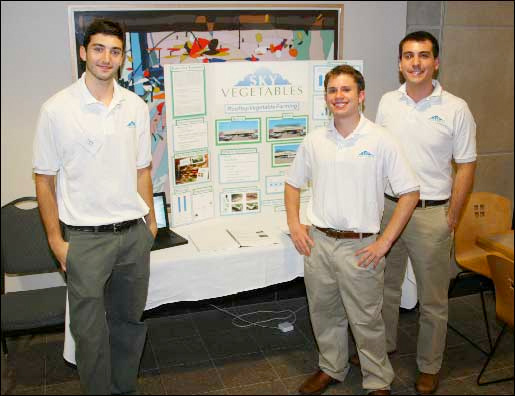
One of the big challenges facing our modern industrial food system is the heavy reliance upon fossil fuels for the growing of crops, and the transporting of them long distances to market. An average head of lettuce travels 1500 miles before reaching the supermarket shelf, a longer distance than many of us travel on vacation. But what if our fresh produce could be grown in the supermarket, the same destination point where it eventually would be sold?
One enterprising, 22 year-old University of Wisconsin—Madison business student, Keith Agoda, came up with the idea to grow fruits and vegetables on the rooftops of supermarkets after a trip to Chicago where he witnessed first-hand community gardens feeding local area residents. Thinking back upon an earlier trip to South America where he experienced fresh produce from street vendors throughout Buenes Aires, he began thinking about how to grow food efficiently without the need for land. This led to the idea for Sky Vegetables, the creation of an urban agriculture firm that specializes in the building and managing of rooftop gardens for sale of produce to supermarkets situated directly below.
Working on his business plan for college credits, along with fellow university student Troy Vosseller together they submitted their plan into the G. Steven Burrill Business Plan Competition, an annual competition to choose the best start-up ideas by a panel of four judges.
Sky Vegetables works with hydroponics, 4 times less weight than traditional soil, an important requirement considering that weight is a critical factor for a a greenhouse structure designed to fit on a 40,000 square foot rooftop. Hydroponics, a nutrient rich solution, can be precisely monitored, and kept in balance, to provide upwards of 5 to 15 times the equivalent yield from that of farmlands, and produces significantly less pollution, and greenhouse gas emissions. Sky Vegetables design also uses recycled rainwater for irrigation, organic nutrients for the hydroponic soils, and solar panels for energy production, allowing for year-round, and sustainable production in most types of climate.
While the fixed costs for such a building are projected to run between $350,000-$425,000, the system is designed to run quite inexpensively moving forward, and projected to be paid off within 19 months. What would be some of the marketing advantages of adopting a Sky Vegetables service on your supermarket rooftop? Besides predictable access to fresh supplies of produce, the potential for a long-term hedge against rising fuel and transportation prices, packaging, and fertilizer costs that must be factored into the wholesale price of buying standard produce; those costs would almost entirely be eliminated.
For those that may see this as a niche novelty idea, consider this: in New York City alone, hydroponic greenhouses, placed on the city’s 14,000 acres of available, unshaded rooftops— currently unused—could feed 20 million people— year-round! Considering the rising price of peak oil, the environmental impact of industrial farming, and the effects of agriculture production on climate change, this may be an idea whose time has come.
Oh, and by the way, the competition that Sky Vegetables entered: they took 1st prize, $10,000.
Related: Environmentalist dreams of New York rooftop farms ;
FOOD FROM THE ROOF (this article contains a photo of a hospital in Singapore with a rooftop greenhouse that feeds hospital patients)
This post was written by Fred Gerendasy, a contributor to Cooking Up a Story as a writer and occasional interviewer. His current work is featured at Fred Gerendasy Photography.
